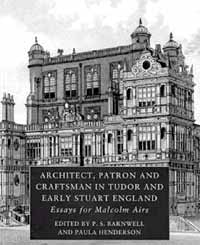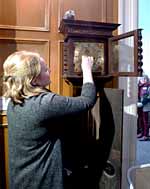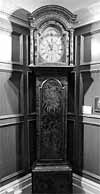News for Spring 2018
Wollaton Hall article

Pete Smith has published a paper on 'Wollaton Hall and New Hardwick Hall' in a volume entitled Architect, Patron and Craftsman in Tudor and Early Stuart England.
Continuing the great series of Rewley House Studies published by Shaun Tyas (2017) this new volume of essays is dedicated to Malcolm Airs. The essays were from papers read at a conference held at Rewley House in 2016. The book is 208 pages long (vi + 202), is printed in colour throughout and bound in sturdy boards covered in real cloth, with a handsome colour dust wrapper showing a Victorian print of Wollaton Hall.
ISBN 978-1-907730-62-7. The normal retail price is £40 and the book can be obtained from Shaun Tyas, 1 High Street, Donington, Lincolnshire, PE11 4TA, UK; telephone 01775 821542; email: shaun@shauntyas.myzen.co.uk
Further information from Pete Smith at pete21smith@gmx.com
Clipstone Colliery Headstocks
We have heard from Sir Neil Cossons, one of our Vice-Presidents, that a group of Industrial Archaeologists has been awarded a grant by the Heritage Lottery Foundation for a detailed survey and feasibility study of Clipstone Colliery headstocks. Heritage England are also providing a grant in support. The Clipstone Colliery headstocks are Nottinghamshire’s most important ‘building at risk’ and so this funding is timely, and progress can now be made towards their conservation. We hope to bring more information in a future Newsletter.
Historic towns atlas
This very useful and interesting website is intended to provide, in due course, a set of maps for each town and city in England. So far, twenty-two towns are included, one of which is Nottingham.
The Nottingham section begins with an extensive article on the history of Nottingham written by Prof MW Barley and IF Straw. There is then a series of seven maps from various times, covering Nottingham in the 9th to 12th centuries; Nottingham c.1800; Nottingham’s mediaeval street names, and the Nottingham boroughs, parishes and wards in the 18th century. The site is easy to use, very informative and well worth a visit, at www.historictownsatlas.org.uk
Atlas of Hillforts
Another website of possible interest is the Atlas of Hillforts of Britain and Ireland, published by a consortium including the universities of Oxford and Edinburgh, and the Arts and Humanities Research Council. The atlas consists of an interactive Google map of the British Isles, with all known hillforts marked with a small circle. Pointing the cursor at one of the circles brings up a box with standard information on each site. There is an interesting cluster of eight hillforts to the north of Nottingham, including Camp Hill near Kirklington, Burgage Hill at Southwell, Dorket Head camp and the well-known Oldox camp near Oxton. One wonders why the area was so heavily fortified. There are two more camps further away to the west. The atlas can be found at hillforts.arch.ox.ac.uk.
Clock-winding at the British Horological Institute Museum of Timekeeping

Have you ever wondered who has the job of winding the several hundred clocks at the Museum of Timekeeping at the British Horological Institute at Upton Hall? Apparently it takes two people half a day each week just to wind clocks. Intrepid as ever, your Editorial Team, who are Friends of the Museum, went to Upton Hall recently to observe the winding. The two ‘winders’ were Ellie the Museum Manager and Alex the Collections Officer.
This clock resents being moved and will 'sulk' for days if it is moved even slightly when being cleaned.
Wednesday each week is ‘winding day’ and the winders were equipped with a variety of winding keys. Most were modern, and not the originals, as keys become worn and can damage the mechanisms.

Long-case clock
As they lovingly wound each clock, the two ladies talked about the clock and its characteristics, sometimes its eccentricities (some clocks complain loudly if they are moved even a fraction of an inch) and any special precautions taken when winding. Many clocks are weight-driven and the clock weights are supported by the winder’s free hand as the clock is wound. This reduces the strain on the mechanism of the clock.
Future events planned at the Museum include a second Winding Day on Wednesday 21st February 2018 between 10.30am and 12.30pm. The cost is £5 per person, but free to Friends of the Museum.
There is a special celebration of the clocks going forward one hour to British Summer Time on Sunday 25th March, the Museum’s Summer Show is on Sunday 1st July and the ‘Fall Back’ Day to mark the return to GMT is on Sunday 28th October. Further information can be obtained from www.bhi.co.uk.
A note from your Newsletter Editor - in my view, the term ‘Grandfather clock’ is an ugly Americanism. An English clock is a Long Case Clock!
John Wilson
ANNIVERSARIES
100 years ago
If you would like to hear more about the 1917 escape of German prisoners of war from Sutton Bonington, go to http://www.bbc.co.uk/programmes/p029zc5c. Two of our members, Christine Drew and Richard English, discuss the breakout and what happened next.
150 years ago
On 1st January 1868 there was a ‘tremendous gale in Nottingham and throughout the county, which did much damage’.
On 13th April 1868, Easter Monday, the Nottingham Free Library was opened. The Nottingham Naturalists’ Society had suggested, in 1863, that a Free Library be opened in Nottingham but nothing was done for several years. By 1867, the Artizans’ Library, based in Thurland Street, was in financial difficulty and the library was purchased by the Town Council. The Nottingham Naturalists’ Society offered their library and museum to the Town Council and the offer was accepted. The Free Library was set up in the former premises of the Artizans’ Library and the library was opened by the mayor, Alderman John Barber, who borrowed the first book.
In April, the Free Grammar School moved from its premises in Stoney Street to its handsome new building on Arboretum Street, and its name changed to Nottingham High School. The foundation stone had been laid in October 1866.
200 years ago
On 4th February 1818, at a public meeting of the Gentry of the town, it was resolved to establish the Nottingham Savings Bank.
In March, at the Crown Assize Court, ‘an unusual number of prisoners were condemned to death’. Their number included several convicted of burglary. Lucy Wain, aged 40, was condemned for uttering a counterfeit shilling in payment for half a pound of butter and William Goode aged 16 for stealing a scarf from a shop. Eventually, all but two were reprieved. The latter two had committed numerous robberies. One, George Needham aged 21, had been discharged from the employ of a clergyman in Newark and had been obliged by his master to enter the Marines in lieu of being reported. Needham had deserted form the Marines and with his colleague William Mandeville aged 22 had embarked on a life of crime. The pair were hanged on 3rd April. Mandeville appeared sincerely contrite, but his companion was ‘as hardened and insensible as can well be conceived’.
April 1818 saw the opening of the Salem Chapel on Barker Gate, built at a cost of £2,000. The occupation of the chapel did not last long, and after a debt of £900 was ‘pressing down upon the energies’ of the members of the chapel, it was let to a group ‘known as the Arminian Methodists’. In 1839, the building was sold for £824 to a group who established the chapel as a meeting place for a group of Baptists who called themselves the ‘New Testament Disciples’.
250 years ago
In 1768, Richard Arkwright, who had been born in Lancashire, became a resident of Nottingham. His invention of the ‘spinning frame’ had occurred at around the same time as that of the ‘spinning jenny’ by Hargreaves. Having been driven out of Lancashire by a ‘lawless mob’, Arkwright set up a small mill in Nottingham, on a piece of ground between Woolpack Lane and Hockley. The mill was worked by horses. However, the use of horses proved to be too expensive, and steam power was in its infancy, so Arkwright moved to Cromford in 1771. Here he built his famous water-powered mill, and Nottingham ‘lost the benefit of being the cradle of his invention’.
300 years ago
In 1718, the Rev Humphrey Perkins, rector of Holme Pierrepont, left in his will £30, to be held by the rector and Churchwardens of Holme Pierrepont, and the interest to be distributed each Christmas Day to the poor of Holme Pierrepont.
Marmaduke Pennell was appointed Mayor of Nottingham in 1817; Richard Smith and Jonathan Truman, sheriffs.
350 years ago
In 1668, Henry Stone left £300 to be settled in trust by his executors, for the foundation of a Jersey spinning school in Newark, and for the employment of poor people. In that year, John Parker was appointed Mayor, and Joseph Clay and Edward White, sheriffs.
400 years ago
Mr Rockett, who had been disenfranchised for not paying his fine, or making a sheriff’s dinner, submits himself to the censures of the company, and is therefore restored to his burgess-ship, and to all his former privileges.
[The above information is taken from the Nottingham Date Book - Ed.]